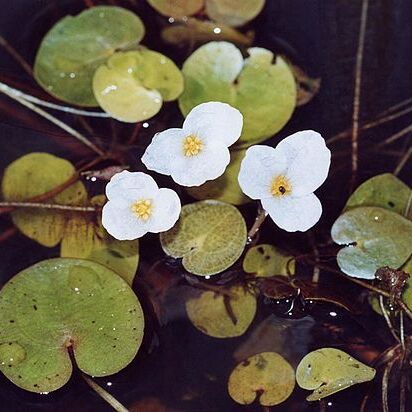Herbs, annual or perennial, caulescent or without evident stem, glabrous or pubescent, entirely submersed, with both submersed and floating leaves, or with submersed stolons and emergent leaves, in fresh, brackish, or marine waters; turions rarely present. Stems rhizomatous, creeping, with abbreviated erect axis at nodes, or erect, leafy, elongate. Leaves basal, alternate, opposite, or whorled, sessile or petiolate; stipules sometimes present, forming tubular sheath around stem; blade margins entire or serrate; veins 1--many. Inflorescences axillary, terminal, or scapose, 1-flowered or cymose, subtended by spathe; spathe a 2-fid bract or pair of opposite bracts. Flowers unisexual, staminate and pistillate on same plants or on different plants, often with rudiments of opposite type, or bisexual, actinomorphic, rarely slightly zygomorphic; perianth epigynous, free, mostly 6-parted, then differentiated into sepals and petals, rarely 3-parted, then petals absent in Thalassia and Halophila; stamens (0--)2--many in 1 or more whorls (inner often staminodial), epigynous, distinct or ± connate; pollen spheric, in monads or tetrads or in slender chains; ovary 0--1, if present, inferior, 2--6[--16]-carpellate, 1-locular or falsely 6--9-locular; placentation parietal. Fruits berrylike. Seeds many, fusiform, ellipsoid, ovoid, or spheric; seed coat glabrous, papillose, or echinate.
Submerged, monoecious or dioecious, annual orperennial aquatics. Stem internodes sometimes with spines. Leaves insubopposite pairs and usually in pseudowhorls of 3–7, sessile, with open foldedbasal sheath and linear blade. Sheath with or without auricle; sheath of secondleaf clasping main branch; sheath of first and third leaf clasping side branchor flower; basal part of sheath enclosing 2 minute axillary intra-vaginalhyaline scales (prophylls); upper part mostly serrulate or spiny-dentate. Blade1-veined; apex acute to acuminate with 1–3 spines or teeth per side; marginsserrulate with small spines. Inflorescences unisexual, a solitary flower atvery base of axillary shoot, or 2 or 4 flowers per axil. Male flowers sessile,with thin inner envelope (involucre or perianth) bilobed at apex, closelyadhering to anther; peduncle elongating at anthesis, pushing anther throughenvelope; anther subsessile, uni-or tetrasporangiate, dehiscing irregularly;pollination hydrogamous. Female flowers subsessile; ovary ovoid, unicarpellate,1-loculed, ending in short, cylindric style with 2 or 3 (rarely 4) linear,often unequal stigmatic branches; ovule solitary, erect, anatropous. Fruit a1-seeded achene. Seed ellipsoidal-obloid to ovoid; testa distinctly areolate.
Freshwater or marine, dioecious or monoecious or rarely bisexual, annual or perennial aquatics, usually attached. Leaves submerged, floating or emergent, cauline or all basal, alternate, opposite or whorled. Inflorescences submerged, floating or emergent, spatheate, 1–many-flowered, axillary. Flowers 2-or 3-merous, actinomorphic, bisexual or unisexual, if unisexual the males usually in many-flowered inflorescences and the females solitary. Perianth segments and stamens usually borne at summit of long hypanthium above inferior ovary, the hypanthium length related to water depth. Perianth segments in 1 or 2 whorls, if 2 whorls the inner usually petaloid, each whorl of 2 or 3 segments. Stamens 1–many; staminodes sometimes present. Ovary inferior; carpels fused, 2–15. Fruit dry or fleshy, indehiscent or regularly dehiscent. Seeds numerous, variously ornamented.
Herbs, annual or perennial, submerged or floating, aquatic, in fresh or brackish water or marine. Stems short or elongated, sometimes stoloniferous. Leaves radical or cauline, alternate, opposite, subopposite, whorled, or pseudowhorled, sessile or petiolate, usually sheathing at base. Flowers unisexual or bisexual, actinomorphic, enclosed in a bifid spathe or within 2 opposite spathal bracts, or rarely not spatulate; spathes sessile or pedunculate. Stamens 1 to many, occasionally some staminodal; anthers 1-4-thecous. Ovary inferior, 1-loculed; carpels 2-15, fused; ovules few to many, on parietal, sometimes intruding placentae; styles 2-5; stigmas usually bifid. Fruit a fleshy and berrylike capsule dehiscent or opening by decay of pericarp, or an achene (Najas). Seeds numerous, usually small, without endosperm; embryo straight.
Flowers hermaphrodite or unisexual, arranged in a tubular spathe or within two opposite bracts, females solitary; peduncle sometimes spirally twisted in fruit
Perianth-segments free, 1-2-seriate, 3 in each series, the outer often green, valvate, the inner petaloid
Ovary inferior, 1-locular, with parietal placentas sometimes protruding nearly to the middle of the ovary
Fresh-water or salt-water herbs, partly or wholly submerged; roots sometimes floating
Staminodes usually present in the female flower
Leaves radical or cauline, alternate to whorled
Male flowers with rudimentary ovary
Seeds numerous, without endosperm
Fruit rupturing irregularly
Stamens numerous to 2
Ovules numerous

